Summer rummin’
Last month, I finally had the opportunity to check off a box on my spirits-pro bucket list: experiencing a Jamaican dunder pit.
A Jamaican what pit? In brief, it’s a giant, mucky vat used by some rum makers in which leftovers—fibrous bits of sugar cane, yeast residue and other solids and liquids remaining in the still—are dumped and allowed to slowly ferment with wild yeast, like a sourdough starter on steroids. Sour mash bourbons also use a portion of spent grains after distillation to jump-start a new fermentation process, so this may sound familiar to whiskey fans.
The Hampden distillery, operating since 1753, is a hit among high-end rum collectors.Source: Hampden Estate Rums
Yet the dunder pit takes it to whole new level. I can see how rumors start about bat heads and other animal remains tossed into the muck—though I’m assured these are just tall tales.
Frankly, it’s not cute. The murky, ominous-looking sludge bubbles and foams like a cauldron, and exudes a wildly funky, aged-cheese-and-molasses-y stench that could knock you right off your barstool. But it was an absolute delight.
If only this image was scratch ’n’ sniff: Hampden’s dunder pit.Photographer: Kara Newman
That aroma represents the magic that gives Jamaican rum its signature “funk,” that overripe-banana-like tone that distillers refer to as “hogo.” It’s also an essential step for creating esters, organic compounds that contribute to a rum’s aromas and flavors—and, many rum lovers say, the more the better.
Jamaican rums in particular are often described as “high-ester rum,” and while that’s not universally true, or even unique to Jamaica (you’ll find great examples in Barbados, Martinique, etc.), that high-ester punch is easy to recognize. If you want to learn more, Cocktail Wonk’s Matt Pietrek has a great deep-dive explainer.
Because spirits can be presented in shiny bottles, it’s easy to forget that they’re agricultural products. But driving past Jamaica’s vast sugarcane fields and experiencing a dunder pit up close reminded me how important rum and sugar cane are to the island’s cultural and agricultural heritage as well as to its economy.
Right now, Jamaica is in the throes of an ongoing dispute about what can and cannot be called “Jamaican rum.” Of note, last year Jamaica’s Intellectual Property Office approved an amendment to the geographical indication (GI) designation, stating that rum distilled in Jamaica but aged elsewhere is no longer eligible to be recognized as Jamaican rum. However, parties who want to age Jamaican rum outside Jamaica are pushing back, and the legal battle continues.
Much of the furor boils down to transparency, explained Peppie Grant, manager of Hampden Estate, as he guided a tour of the distillery. His view: “As long as they’re not trying to claim that the flavor comes from aging outside Jamaica, it’s OK,” he said. After visiting the relatively small Hampden as well as rum giant Appleton Estate, and sampling countless other Jamaica rums, I can understand why producers would be so protective of one of their key cultural exports.
Returning home to New York after getting dunder-struck, I looked around and more fully felt the Caribbean-inspired cocktail moment we’re in. From the lauded daiquiris at Momofuku’s Bar Kabawa (celebrating all of the Caribbean, with a special hug to Barbados from chef Paul Carmichael) to the new Red Bar within the Printemps department store (focusing on Gregory Gourdet’s Haitian heritage and Caribbean/French spirits broadly) to Afro-Caribbean drinks at Tatiana by Kwame Onwuachi (where Bloomberg’s food editor is still dreaming about the mushrooms), it's exciting to see ingredients such as sorel and clairin—not to mention lots of Caribbean rum—claiming a long-overdue spotlight.
Jamaica’s rum inevitably finds a place among these drink menus, just as it’s finding a place among the cabinets of high-end spirits collectors. And when summer hits, it feels doubly right to pour.
So here are a few key bottles for those who want to experience a bit of hogo without hovering over an odoriferous dunder pit (unless that’s your kind of thing, of course—you’ll find no funk-shaming here). These rums are fruity and approachable, with just a whisper of Voldemort funk-that-shall-not-be-named.
Hampden Estate Great House 2024 ($131)
It’s unabashedly intense and funky, with tons of tropical fruit (think coconut, mango) on nose and palate. Aging in emptied bourbon casks adds a fleeting hint of dark chocolate. While visiting the distillery, I had a chance to sample the forthcoming vintage 2025 bottling, which was newly pulled from the barrel. It tasted like bananas foster, but crisp and bone-dry. I’m looking forward to the day it makes its way stateside.
Transcontinental Rum Line: Jamaica 2016 ($66)
I tried this bottling, which is part of a lineup of world rums from independent bottler La Maison & Velier, at last year’s New York Rum Fest, and it put me in mind of caramelized banana and grilled pineapple with lots of fresh-ground black pepper. The seafaring graphics on the label definitely inspire a bit of wanderlust, but also speak to how it’s made on two continents: distilled and aged for four years in Jamaica, then matured one more year in Europe. Wherever it lands on the “Is it or isn’t it Jamaican?” GI-designation battle, it’s a memorable sip worth seeking out.





















